2023 TOYOTA 86 steering
[x] Cancel search: steeringPage 145 of 449
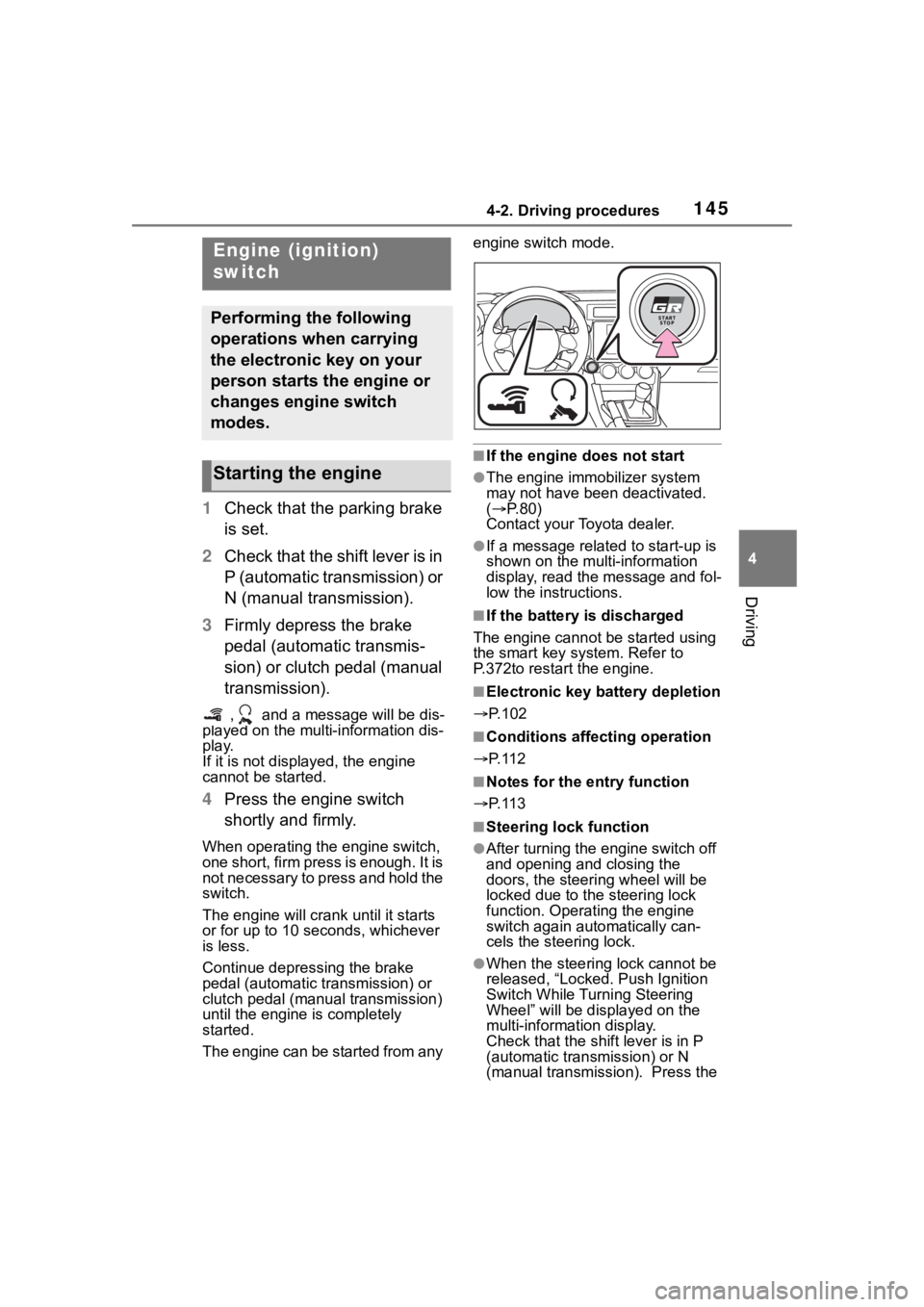
1454-2. Driving procedures
4
Driving
4-2.Driving procedures
1Check that the parking brake
is set.
2 Check that the shift lever is in
P (automatic transmission) or
N (manual transmission).
3 Firmly depress the brake
pedal (automatic transmis-
sion) or clutch pedal (manual
transmission).
, and a mess age will be dis-
played on the multi-information dis-
play.
If it is not displayed, the engine
cannot be started.
4 Press the engine switch
shortly and firmly.
When operating the engine switch,
one short, firm press is enough. It is
not necessary to press and hold the
switch.
The engine will crank until it starts
or for up to 10 seco nds, whichever
is less.
Continue depressing the brake
pedal (automatic tr ansmission) or
clutch pedal (manual transmission)
until the engine is completely
started.
The engine can be started from any engine switch mode.
■If the engine does not start
●The engine immobilizer system
may not have been deactivated.
(
P. 8 0 )
Contact your Toyota dealer.
●If a message related to start-up is
shown on the multi-information
display, read the message and fol-
low the instructions.
■If the battery is discharged
The engine cannot be started using
the smart key system. Refer to
P.372to restart the engine.
■Electronic key battery depletion
P.102
■Conditions affecting operation
P. 1 1 2
■Notes for the entry function
P. 1 1 3
■Steering lock function
●After turning the engine switch off
and opening and closing the
doors, the steeri ng wheel will be
locked due to the steering lock
function. Operating the engine
switch again automatically can-
cels the steering lock.
●When the steering lock cannot be
released, “Locked. Push Ignition
Switch While Turning Steering
Wheel” will be dis played on the
multi-information display.
Check that the shift lever is in P
(automatic transmission) or N
(manual transmission). Press the
Engine (ignition)
switch
Performing the following
operations when carrying
the electronic key on your
person starts the engine or
changes engine switch
modes.
Starting the engine
Page 146 of 449
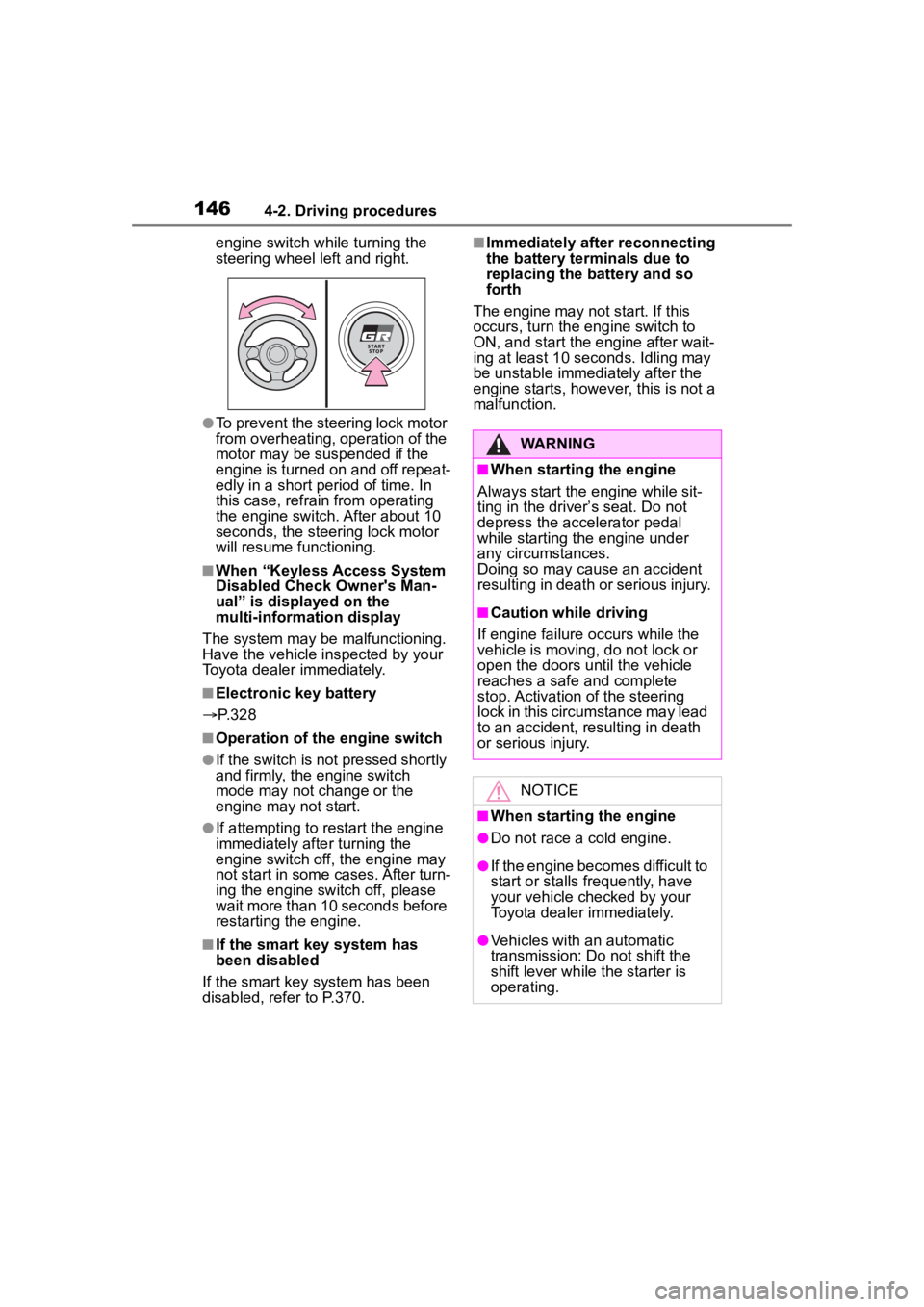
1464-2. Driving procedures
engine switch while turning the
steering wheel left and right.
●To prevent the steering lock motor
from overheating, operation of the
motor may be suspended if the
engine is turned on and off repeat-
edly in a short period of time. In
this case, refrain from operating
the engine switch. After about 10
seconds, the steering lock motor
will resume functioning.
■When “Keyless Access System
Disabled Check Owner's Man-
ual” is displayed on the
multi-information display
The system may be malfunctioning.
Have the vehicle inspected by your
Toyota dealer immediately.
■Electronic key battery
P. 3 2 8
■Operation of the engine switch
●If the switch is not pressed shortly
and firmly, the engine switch
mode may not change or the
engine may not start.
●If attempting to restart the engine
immediately after turning the
engine switch off, the engine may
not start in some cases. After turn-
ing the engine switch off, please
wait more than 10 seconds before
restarting the engine.
■If the smart key system has
been disabled
If the smart key system has been
disabled, refer to P.370.
■Immediately after reconnecting
the battery terminals due to
replacing the battery and so
forth
The engine may not start. If this
occurs, turn the engine switch to
ON, and start the engine after wait-
ing at least 10 seconds. Idling may
be unstable immedi ately after the
engine starts, however, this is not a
malfunction.
WARNING
■When starting the engine
Always start the engine while sit-
ting in the driver’s seat. Do not
depress the accelerator pedal
while starting the engine under
any circumstances.
Doing so may cause an accident
resulting in death o r serious injury.
■Caution while driving
If engine failure occurs while the
vehicle is moving, do not lock or
open the doors until the vehicle
reaches a safe and complete
stop. Activation of the steering
lock in this circumstance may lead
to an accident, resulting in death
or serious injury.
NOTICE
■When starting the engine
●Do not race a cold engine.
●If the engine becomes difficult to
start or stalls frequently, have
your vehicle checked by your
Toyota dealer immediately.
●Vehicles with an automatic
transmission: Do not shift the
shift lever while the starter is
operating.
Page 147 of 449
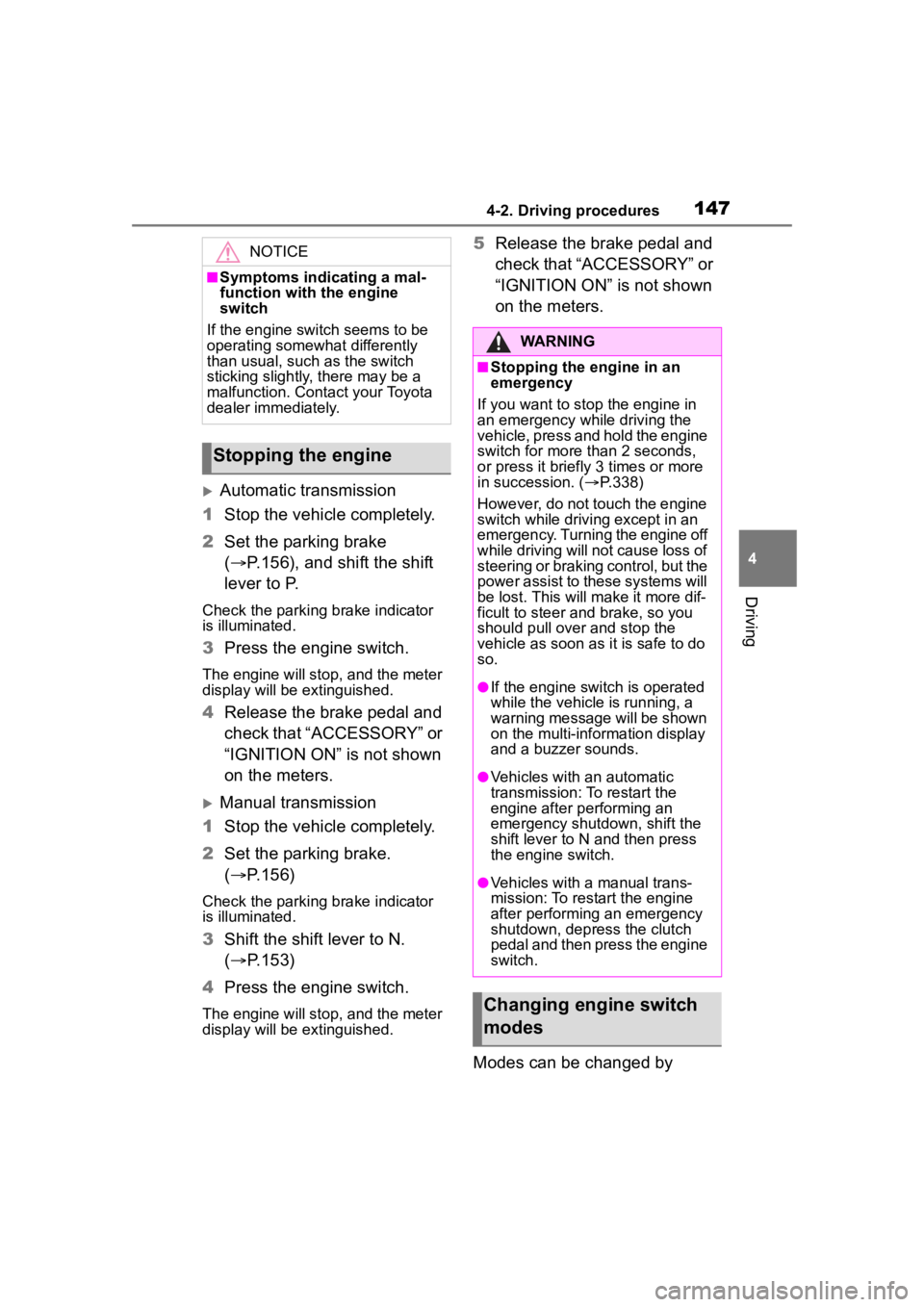
1474-2. Driving procedures
4
Driving
Automatic transmission
1 Stop the vehicle completely.
2 Set the parking brake
( P.156), and shift the shift
lever to P.
Check the parking brake indicator
is illuminated.
3 Press the engine switch.
The engine will stop, and the meter
display will be extinguished.
4Release the brake pedal and
check that “ACCESSORY” or
“IGNITION ON” is not shown
on the meters.
Manual transmission
1 Stop the vehicle completely.
2 Set the parking brake.
( P.156)
Check the parking brake indicator
is illuminated.
3Shift the shift lever to N.
( P.153)
4 Press the engine switch.
The engine will stop, and the meter
display will be extinguished.
5Release the brake pedal and
check that “ACCESSORY” or
“IGNITION ON” is not shown
on the meters.
Modes can be changed by NOTICE
■Symptoms indicating a mal-
function with the engine
switch
If the engine switch seems to be
operating somewh at differently
than usual, such as the switch
sticking slightly, there may be a
malfunction. Contact your Toyota
dealer immediately.
Stopping the engine
WARNING
■Stopping the engine in an
emergency
If you want to stop the engine in
an emergency while driving the
vehicle, press and hold the engine
switch for more than 2 seconds,
or press it briefly 3 times or more
in succession. ( P.338)
However, do not touch the engine
switch while driving except in an
emergency. Turning the engine off
while driving will not cause loss of
steering or braking control, but the
power assist to these systems will
be lost. This will make it more dif-
ficult to steer a nd brake, so you
should pull over and stop the
vehicle as soon as it is safe to do
so.
●If the engine switch is operated
while the vehicle is running, a
warning message will be shown
on the multi-information display
and a buzzer sounds.
●Vehicles with an automatic
transmission: To restart the
engine after performing an
emergency shutdown, shift the
shift lever to N and then press
the engine switch.
●Vehicles with a manual trans-
mission: To restart the engine
after performing an emergency
shutdown, depress the clutch
pedal and then press the engine
switch.
Changing engine switch
modes
Page 161 of 449
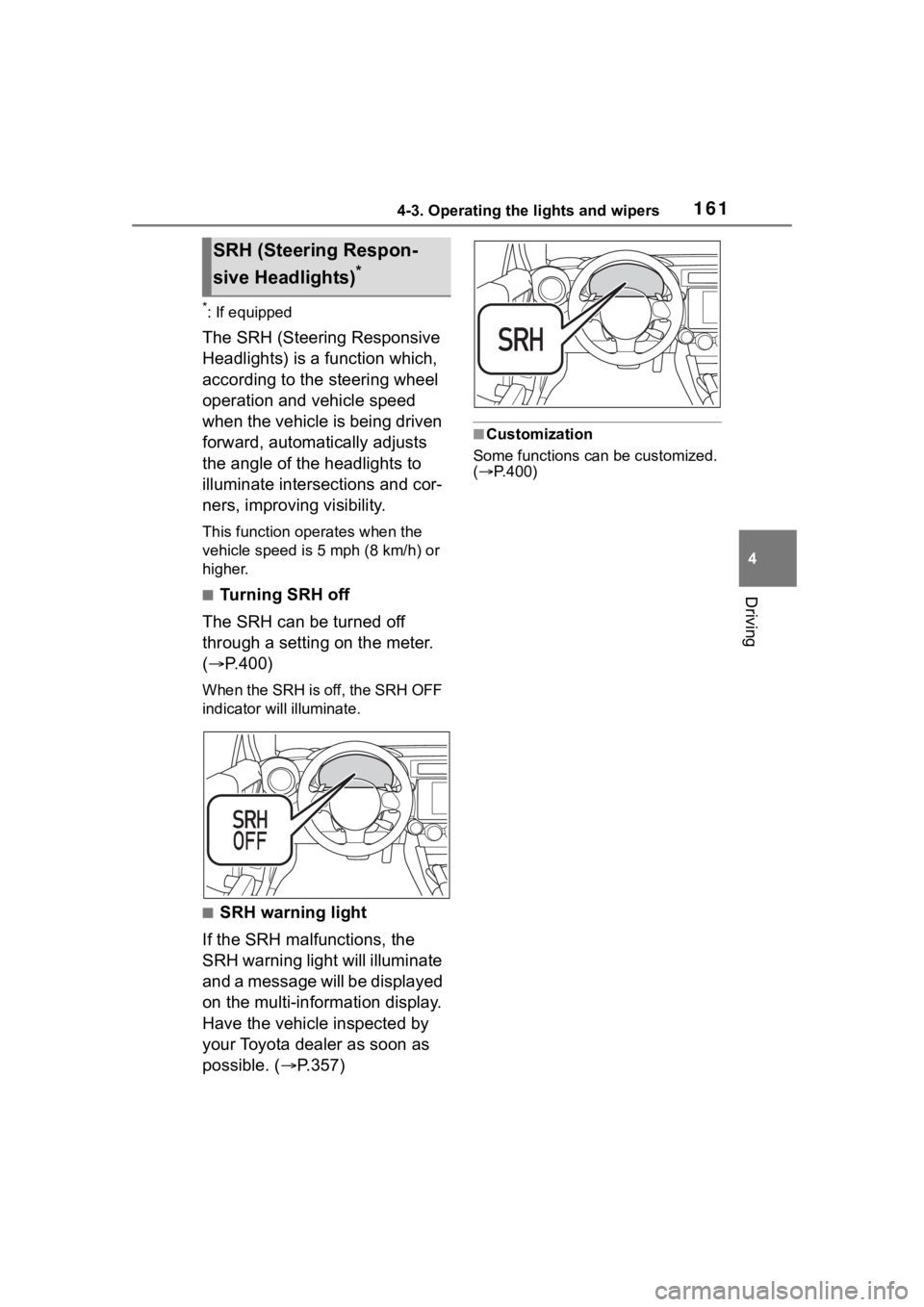
1614-3. Operating the lights and wipers
4
Driving
*: If equipped
The SRH (Steering Responsive
Headlights) is a function which,
according to the steering wheel
operation and vehicle speed
when the vehicle is being driven
forward, automatically adjusts
the angle of the headlights to
illuminate intersections and cor-
ners, improving visibility.
This function operates when the
vehicle speed is 5 mph (8 km/h) or
higher.
■Tu r n i n g S R H o f f
The SRH can be turned off
through a setting on the meter.
( P.400)
When the SRH is off, the SRH OFF
indicator will illuminate.
■SRH warning light
If the SRH malfunctions, the
SRH warning light will illuminate
and a message will be displayed
on the multi-information display.
Have the vehicle inspected by
your Toyota dealer as soon as
possible. ( P.357)
■Customization
Some functions can be customized.
( P.400)
SRH (Steer ing Respon-
sive Headlights)
*
Page 170 of 449
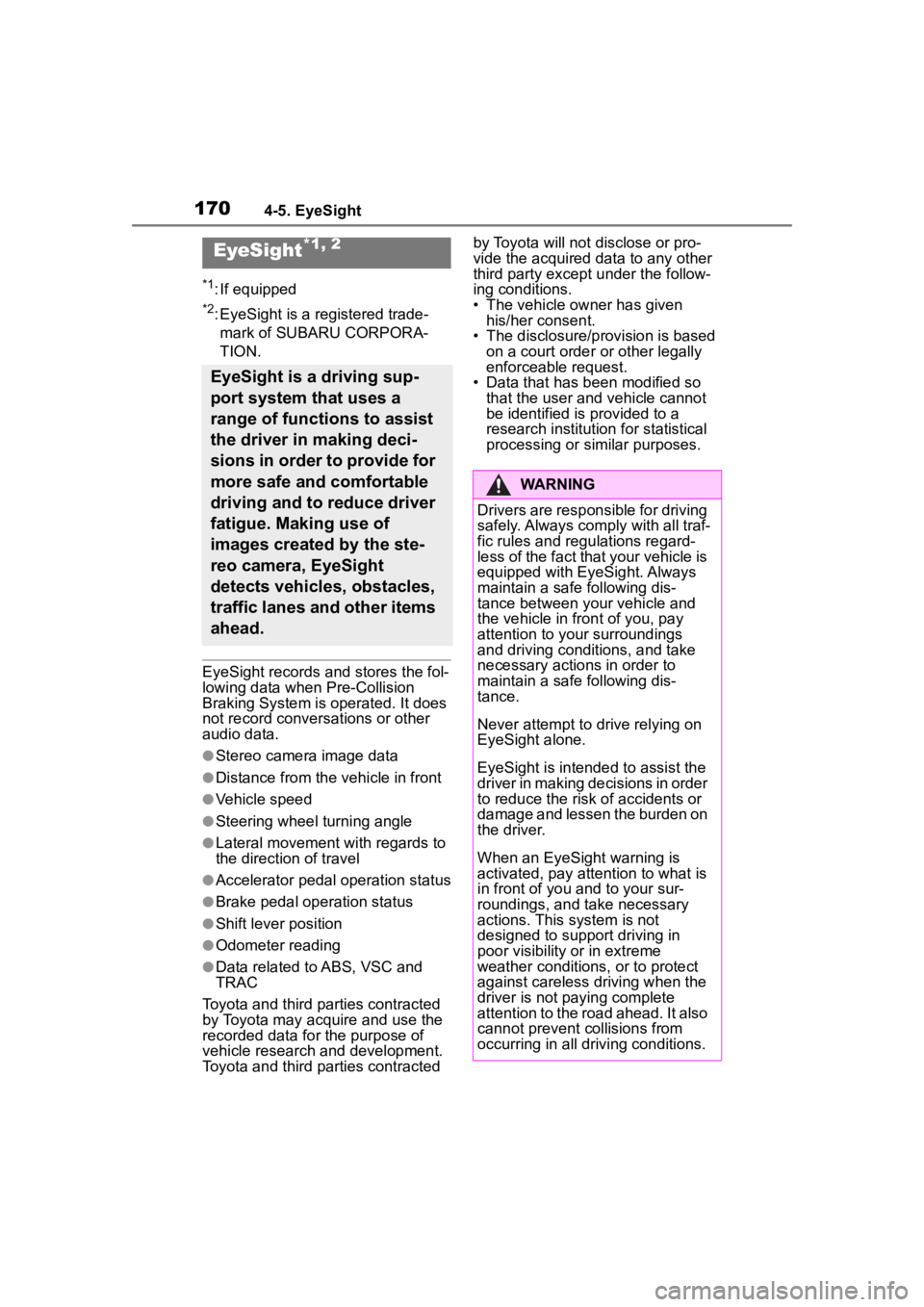
1704-5. EyeSight
4-5.EyeSight
*1: If equipped
*2: EyeSight is a registered trade-mark of SUBARU CORPORA-
TION.
EyeSight records a nd stores the fol-
lowing data when Pre-Collision
Braking System is operated. It does
not record conversations or other
audio data.
●Stereo camera image data
●Distance from the vehicle in front
●Vehicle speed
●Steering wheel turning angle
●Lateral movement with regards to
the direction of travel
●Accelerator pedal operation status
●Brake pedal operation status
●Shift lever position
●Odometer reading
●Data related to ABS, VSC and
TRAC
Toyota and third parties contracted
by Toyota may acquire and use the
recorded data for the purpose of
vehicle research and development.
Toyota and third parties contracted by Toyota will not disclose or pro-
vide the acquired data to any other
third party except under the follow-
ing conditions.
• The vehicle owner has given
his/her consent.
• The disclosure/provision is based on a court order or other legally
enforceable request.
• Data that has been modified so that the user and vehicle cannot
be identified is provided to a
research instituti on for statistical
processing or similar purposes.
EyeSight*1, 2
EyeSight is a driving sup-
port system that uses a
range of functions to assist
the driver in making deci-
sions in order to provide for
more safe and comfortable
driving and to reduce driver
fatigue. Making use of
images created by the ste-
reo camera, EyeSight
detects vehicles, obstacles,
traffic lanes and other items
ahead.
WARNING
Drivers are responsible for driving
safely. Always comply with all traf-
fic rules and regulations regard-
less of the fact that your vehicle is
equipped with EyeSight. Always
maintain a safe following dis-
tance between your vehicle and
the vehicle in front of you, pay
attention to your surroundings
and driving condi tions, and take
necessary actions in order to
maintain a safe following dis-
tance.
Never attempt to d rive relying on
EyeSight alone.
EyeSight is intended to assist the
driver in making decisions in order
to reduce the risk of accidents or
damage and lessen the burden on
the driver.
When an EyeSight warning is
activated, pay attention to what is
in front of you and to your sur-
roundings, and take necessary
actions. This system is not
designed to support driving in
poor visibility or in extreme
weather conditions, or to protect
against careless driving when the
driver is not paying complete
attention to the road ahead. It also
cannot prevent c ollisions from
occurring in all driving conditions.
Page 180 of 449
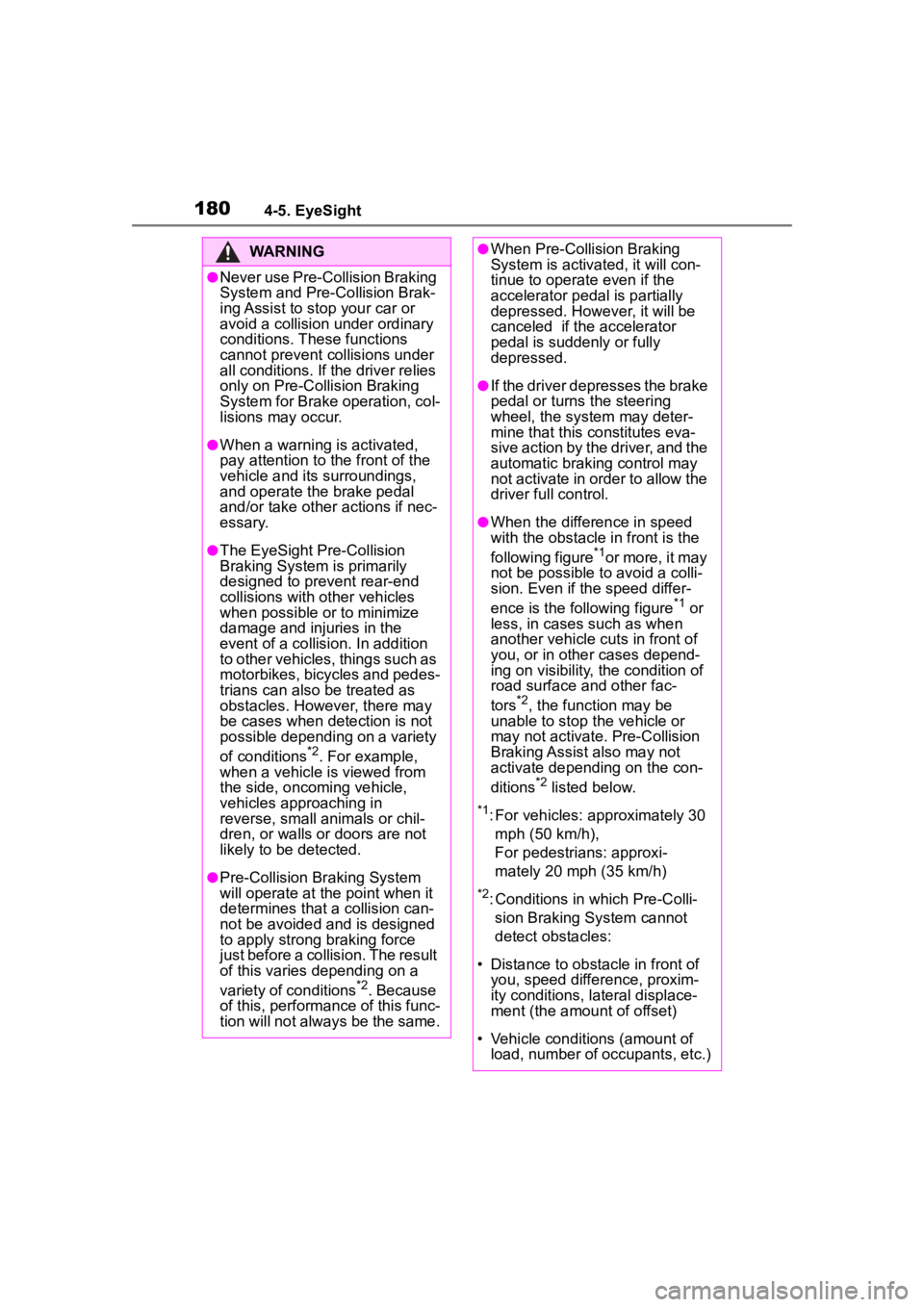
1804-5. EyeSight
WARNING
●Never use Pre-Collision Braking
System and Pre-Collision Brak-
ing Assist to stop your car or
avoid a collision under ordinary
conditions. These functions
cannot prevent collisions under
all conditions. If the driver relies
only on Pre-Collision Braking
System for Brake operation, col-
lisions may occur.
●When a warning is activated,
pay attention to the front of the
vehicle and its surroundings,
and operate the brake pedal
and/or take other actions if nec-
essary.
●The EyeSight Pre-Collision
Braking System is primarily
designed to prevent rear-end
collisions with other vehicles
when possible or to minimize
damage and injuries in the
event of a collision. In addition
to other vehicles, things such as
motorbikes, bicycles and pedes-
trians can also be treated as
obstacles. However, there may
be cases when detection is not
possible depending on a variety
of conditions
*2. For example,
when a vehicle is viewed from
the side, oncoming vehicle,
vehicles approaching in
reverse, small animals or chil-
dren, or walls or doors are not
likely to be detected.
●Pre-Collision Br aking System
will operate at the point when it
determines that a collision can-
not be avoided and is designed
to apply strong braking force
just before a collision. The result
of this varies d epending on a
variety of conditions
*2. Because
of this, performance of this func-
tion will not always be the same.
●When Pre-Collision Braking
System is activated, it will con-
tinue to operate even if the
accelerator pedal is partially
depressed. However, it will be
canceled if the accelerator
pedal is suddenly or fully
depressed.
●If the driver depresses the brake
pedal or turns the steering
wheel, the system may deter-
mine that this constitutes eva-
sive action by the driver, and the
automatic braking control may
not activate in order to allow the
driver full control.
●When the difference in speed
with the obstacle in front is the
following figure
*1or more, it may
not be possible to avoid a colli-
sion. Even if the speed differ-
ence is the following figure
*1 or
less, in cases such as when
another vehicle cuts in front of
you, or in other cases depend-
ing on visibility, the condition of
road surface and other fac-
tors
*2, the function may be
unable to stop the vehicle or
may not activate. Pre-Collision
Braking Assist also may not
activate depending on the con-
ditions
*2 listed below.
*1: For vehicles: approximately 30
mph (50 km/h),
For pedestrians: approxi-
mately 20 mph (35 km/h)
*2: Conditions in which Pre-Colli-sion Braking System cannot
detect obstacles:
• Distance to obstacle in front of you, speed difference, proxim-
ity conditions, lateral displace-
ment (the amount of offset)
• Vehicle conditions (amount of load, number of occupants, etc.)
Page 186 of 449
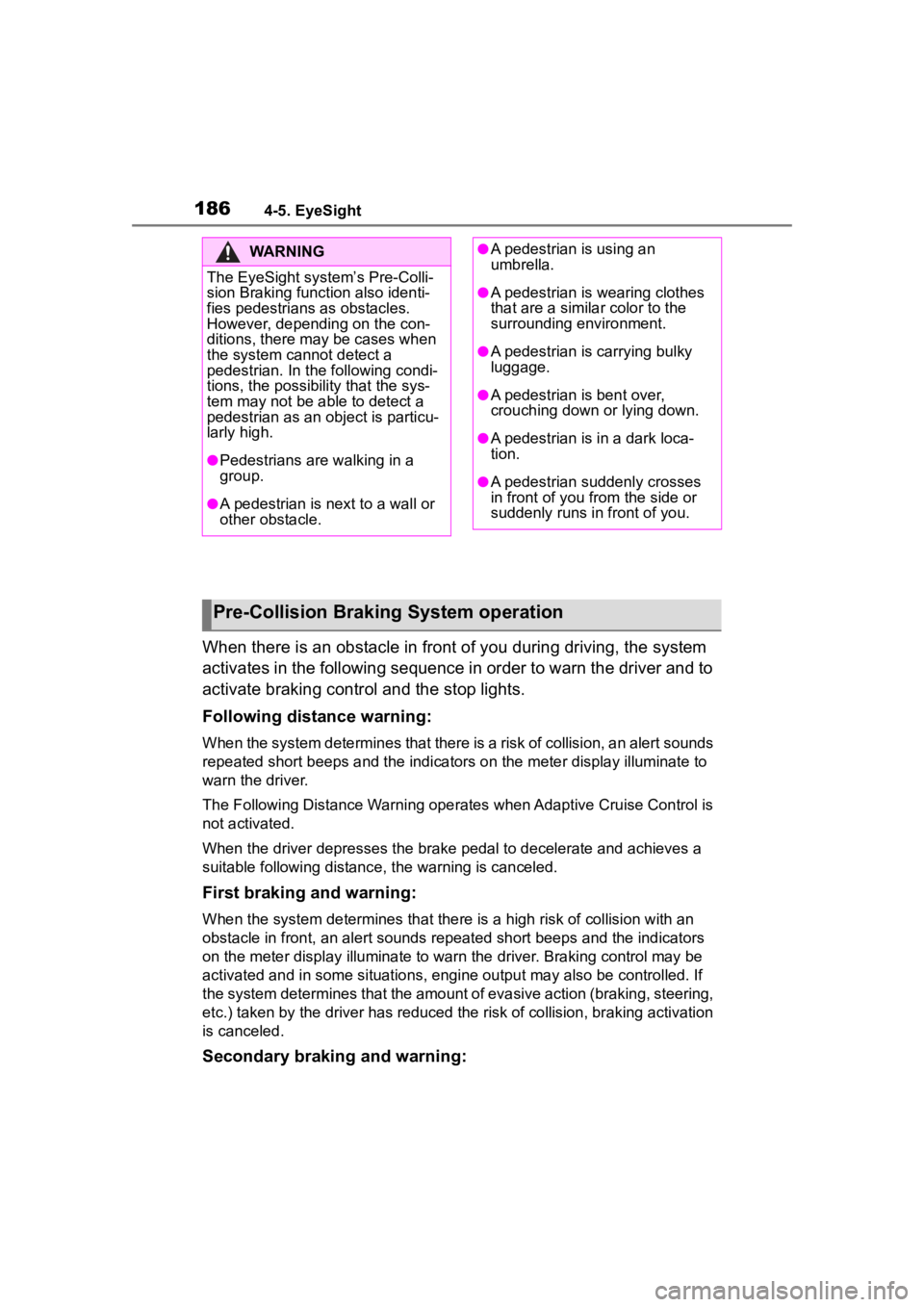
1864-5. EyeSight
When there is an obstacle in front of you during driving, the system
activates in the following sequence in order to warn the driver and to
activate braking control and the stop lights.
Following distance warning:
When the system determines that t here is a risk of collision, an alert sounds
repeated short beeps and the indicators on the meter display il luminate to
warn the driver.
The Following Distance Warning ope rates when Adaptive Cruise Control is
not activated.
When the driver depresses the bra ke pedal to decelerate and achieves a
suitable following distanc e, the warning is canceled.
First braking and warning:
When the system determines that there is a high risk of collisi on with an
obstacle in front, an alert sounds repeated short beeps and the indicators
on the meter display illuminate to warn the driver. Braking control may be
activated and in some situations, engine output may also be controlled. If
the system determines that the amount of evasive action (brakin g, steering,
etc.) taken by the driver has reduced the risk of collision, br aking activation
is canceled.
Secondary braking and warning:
WARNING
The EyeSight system’s Pre-Colli-
sion Braking function also identi-
fies pedestrians as obstacles.
However, depending on the con-
ditions, there may be cases when
the system cannot detect a
pedestrian. In the following condi-
tions, the possibility that the sys-
tem may not be able to detect a
pedestrian as an object is particu-
larly high.
●Pedestrians are walking in a
group.
●A pedestrian is next to a wall or
other obstacle.
●A pedestrian is using an
umbrella.
●A pedestrian is wearing clothes
that are a similar color to the
surrounding environment.
●A pedestrian is carrying bulky
luggage.
●A pedestrian is bent over,
crouching down o r lying down.
●A pedestrian is in a dark loca-
tion.
●A pedestrian suddenly crosses
in front of you from the side or
suddenly runs in front of you.
Pre-Collision Braki ng System operation
Page 197 of 449
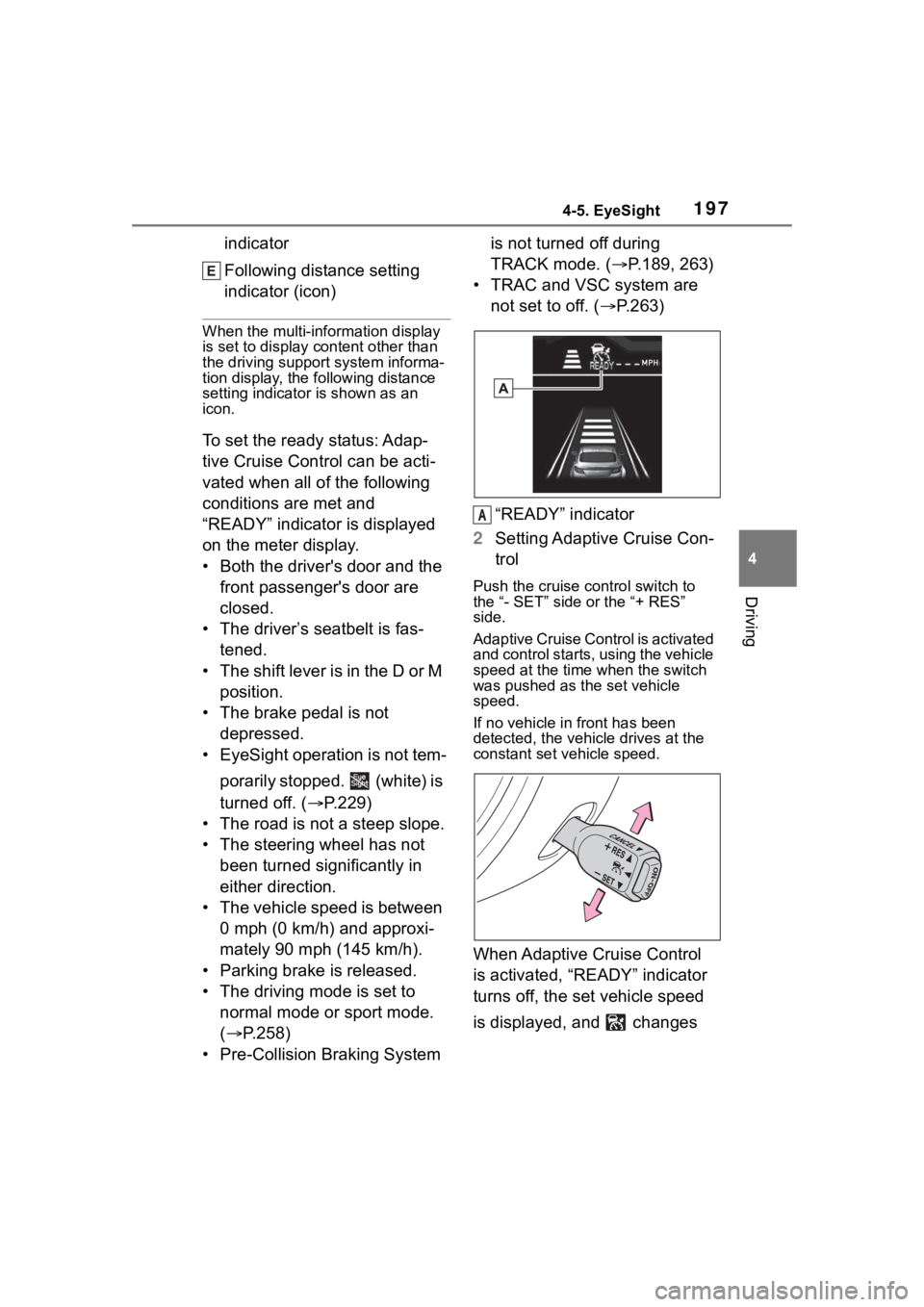
1974-5. EyeSight
4
Driving
indicator
Following distance setting
indicator (icon)
When the multi-information display
is set to display content other than
the driving suppor t system informa-
tion display, the following distance
setting indicator is shown as an
icon.
To set the ready status: Adap-
tive Cruise Control can be acti-
vated when all of the following
conditions are met and
“READY” indicator is displayed
on the meter display.
• Both the driver's door and the
front passenger's door are
closed.
• The driver’s seatbelt is fas- tened.
• The shift lever is in the D or M position.
• The brake pedal is not depressed.
• EyeSight operation is not tem-
porarily stopped. (white) is
turned off. ( P.229)
• The road is not a steep slope.
• The steering wheel has not been turned significantly in
either direction.
• The vehicle speed is between 0 mph (0 km/h) and approxi-
mately 90 mph (145 km/h).
• Parking brake is released.
• The driving mode is set to normal mode or sport mode.
( P.258)
• Pre-Collision Braking System is not turned off during
TRACK mode. (
P.189, 263)
• TRAC and VSC system are not set to off. ( P.263)
“READY” indicator
2 Setting Adaptive Cruise Con-
trol
Push the cruise control switch to
the “- SET” side or the “+ RES”
side.
Adaptive Cruise Control is activated
and control starts, using the vehicle
speed at the time when the switch
was pushed as the set vehicle
speed.
If no vehicle in front has been
detected, the vehicle drives at the
constant set vehicle speed.
When Adaptive Cruise Control
is activated, “READY” indicator
turns off, the set vehicle speed
is displayed, and changes
A